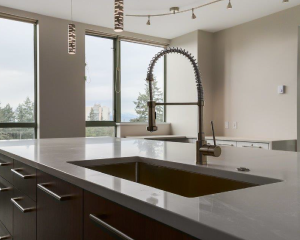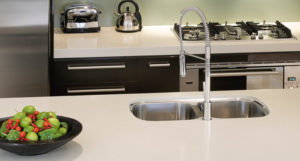 When people say “they took everything but the kitchen sink,” the titular sink may have been left behind because they are notoriously difficult to remove. The idea behind this phrase is that everything that could be moved was – but the sink, fixed in place, was impossible to transport. Or, maybe, it’s just that the sink is too absolutely vital to the kitchen structure to be taken, even by an ill-meaning thief.
When people say “they took everything but the kitchen sink,” the titular sink may have been left behind because they are notoriously difficult to remove. The idea behind this phrase is that everything that could be moved was – but the sink, fixed in place, was impossible to transport. Or, maybe, it’s just that the sink is too absolutely vital to the kitchen structure to be taken, even by an ill-meaning thief.
There are so many parts of the home that are necessary and are used frequently, but none quite so much as the kitchen sink. The kitchen sink is not only used often but is used for a variety of different tasks. Choosing the right kitchen sink is a huge deal. It might even be one of the most important decisions you make for your kitchen space.
With this in mind, we, at RJS Stonetops, have a few recommendations for selecting the right sink style and configuration for your kitchen:
- Choosing Number and Configuration
Single Sink, Large
Pros: You can soak large dishes and perform heavy duty washing tasks with the extra room. Large quantities of food can be washed and prepared.
Cons: It may be hard to juggle layers of action in a single basin.
The average kitchen sink is about 33 to 36 inches wide and 8 to 10 inches deep. Kitchen sinks have been getting larger and deeper, but this size is the perfect balance of space and efficiency. If you need more room, accessories can help to manage the space.
Double Sink, Different Sizes
Pros: Different sizes can be customized for different, simultaneous tasks.
Cons: The smaller basin will lack some functionality regarding larger dishes and heavier tasks.
A common orientation is 60/40, where the sink has one basin that is usually about 18 inches wide and another that is 14 inches wide. Cleaning and heavy tasks can be done in the larger basin and lighter prep work can use the smaller basin. This offers lot of flexibility and can be very useful when attending to busy, diverse kitchen tasks.
Double Sink, Same Sizes
Pros: Lots of room to maneuver and work. Any task can be completed in either sink.
Cons: Takes up extra room. Somewhat out of fashion nowadays.

A 50/50 sink, with two basins both of the same size, is a great symmetrical design choice. Plenty of room to work, though you’ll have to dedicate a good chunk of counter space to accommodating the basins. Gemini Kitchen Sinks come in many variations of single and dual sink configurations, so you can browse the wide selection and pick the one that fits with your ideal kitchen design.
Triple Sink, Two Large and One Small
Pros: Plenty of room. A garbage disposal can be placed in the smaller sink.
Cons: If the smaller sink (with garbage disposal) is between the other two, you can’t “sweep” food scraps from the counter into the disposal. This set-up will take up more counter room, too.
Consider that access to the garbage disposal might be limited if installed between two larger basins, which is a common arrangement.
- Choosing A Sink Shape
Farmhouse
Pros: Farmhouse sinks have an “apron” front, which looks great with any vintage decor scheme. A farmhouse sink can sit slightly beyond the counter line, where “regular” sink orientations tend to be about 4 inches away from the edge of the countertop. Can be great for accessibility. You can also choose a Double Farmhouse design, though this detracts from the vintage aesthetic somewhat.
Cons: The farmhouse sink is a bold style statement, so make sure you love the look…and are willing to live with it for the foreseeable future.
Rounded Sides
Pros: The curved edges make it easier to clean, according to many home owners.
Cons: It doesn’t fit with the sleek, minimalist aesthetic of many modern day kitchens.
Built-In Drainboard
Pros: Great for lots of hand washing tasks, be it dishes or food. The drainboard is a great accessory with plenty of practical uses.
Cons: Takes up room to have the added drainboard function.
- Choosing a Sink Material
Stainless Steel
Pros: Stainless steel is easy to keep clean and maintain and is quite durable. A very classic material that goes with many design schemes.
Cons: May scratch, though small scuffs can be buffed away. Hard water may leave water spots.
Porcelain
Pros: A traditional material that looks great in vintage-style decor schemes. It works well if you want to play with color in your design. Gemini Kitchen Sinks come in stainless steel and porcelain varieties and they carry a lifetime warranty.
Cons: Porcelain can chip, leaving your sink blemished. Materials like metal pans or other severe items may leave scratches or marks.
Granite Composite
Pros: Resistant to chips, scratches, and water spots. Great for if you live in an area with hard water, which will otherwise leave spots.
Cons: LIghter colored granite can stain and may need special maintenance.
Natural Stone
Pros: Soapstone is a common choice but not the only option. Customizable colors and styles means that it can exactly match your countertops or whatever design scheme you are aiming for.
Cons: Costs more and may scratch and chip. May require specific cleaning products and maintenance instructions.
- Choosing Sink Accessories
Pros: Many things can be added to your sink to make it serve a variety of extra functions (think: cutting boards, drying racks, prep bowls, knife blocks, and more). Prep work before and after meals just got a lot more convenient.
Cons: In order for these items to fit your sink configuration, you’ll want to buy them directly from the sink manufacturer or a specialty designer. If you are a “less is more” homeowner, then maybe skip on the added parts. You will also need to consider storage locations for accessories that are not in use.
Looking for a kitchen countertop to go with your new sink? Check out RJS Stonetops’ recommendations for choosing the right kitchen counter for your home.
